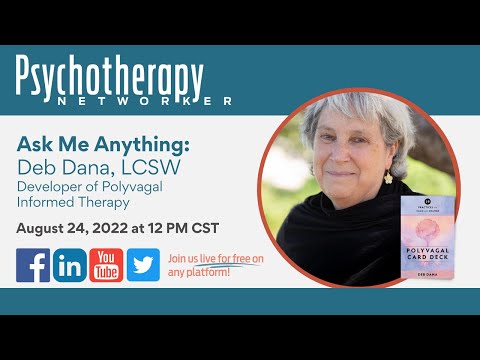We all know people who seem to have the magic touch when it comes to relating to others. They have a way of calming a tense situation and putting people at ease. They instantaneously connect with strangers on the bus or while waiting in line. Neighbors gather around them at the block party. Waiters squat down by their table to carry on animated conversations that have nothing to do with the menu. What makes people like and trust them so immediately?
Therapists with this ability have a natural advantage in practicing their craft. It’s like being tall for a basketball player: not the only thing needed to play in the NBA, but still a big asset. For a therapist, it helps to be able to establish a sense of connection quickly with a wary client or gently disarm a hostile one. It’s great to have that just-right timing and sense of playfulness that gets a sullen teenager to crack a smile, or to say “mmm-hmm” with such a sense of deep rapport that it releases a tightly controlled client to finally let go and cry. What does it take to have that kind of vibe and healing presence? I think we’d all agree that it’s some combination of years of practice plus natural talent. But are there specific behaviors common to exceptionally gifted therapists that we can study, practice, and cultivate? Luckily, the answer is yes.
Microbehaviors occur within fractions of a second, most of them not conscious to the sender or receiver, and some greatly contribute to inspiring feelings of safety, connection, and comfort. One way of deepening our understanding of these behaviors is through Stephen Porges’s polyvagal theory, which uncovers their biological structures and their effects on human communication. Porges describes the social engagement system (SES) as the circuitry primarily responsible for regulating certain types of vocalizations, facial expressions, and gestures to elicit feelings of trust and openness in another person. These behaviors are the main ways people exchange messages that signal either safety or danger to the brain. When a human encounters an unfamiliar person, the amygdala—the part of the brain responsible for evaluating trustworthiness—scans the stranger’s nonverbal, nonconscious behaviors and makes a split-second threat analysis. If the amygdala assesses that the stranger is safe, then the SES is activated, and the person becomes receptive to engagement and connection. Let’s take a look at the subtle ways these emotional messages are transmitted.
Voice Prosody
Prosody consists of the timing, phrasing, emphasis, and intonation of words in a conversation, which all help convey aspects of emotional meaning and make our speech lively, convincing, and engaging. It’s conveyed by raising and lowering the pitch of voice, speeding up or slowing down the rhythm of our sentences, and varying the loudness of our words. Even the frequency of breathing within speech can convey a sense of urgency or calmness. The effective use of prosody creates a sense that you’re really following and getting what a person is saying. It’s also a feature of storytelling that keeps listeners interested and curious, holding their attention, and thereby organizing and calming their nervous system.
So how do you produce prosody when you speak? The most elemental model comes from the sounds a parent makes when talking to a four- or five-month-old baby. For example, imagine a father chatting with his baby while dressing her on the changing table. The “dialogue” goes something like this:
Father: (pulling the arm out of the baby’s pajama shirt) Where’s Bella’s arm? Ooooh, there it is! What a big girl you are. You’re getting so biiigggg.
Baby Bella: Ba!
Father: (in a high-pitched, excited tone) That’s right! Big! Who’s a big girl?
Bella: (making a gurgling, babbling noise with her lips): Brrrrrrrrrrrr.
Father: (putting the shirt over Bella’s head, speaking with increasing volume and inflection in his voice) Where’d you go? Where’d you go, Bella? (Pulls shirt to discover baby’s eyes.) Boo!
Bella: (looking momentarily startled, then smiling wide, wiggling her whole body, and squealing as she giggles)
Father: You’re so silly. You’re so silly. I got your tummy. (Leans down to blow raspberries on baby’s belly.) I got your belly!
Bella: (Kicks legs and lets out another, louder squeal.)
Father: You’re so funny, aren’t ya, little girl?
Later, when they’re in the kitchen, Bella’s father uses the coffee grinder, and Bella is startled by the growling, loud noise. She gasps in shock and then lets out a shrill cry.
Father: (speaking with quick, urgent breaths) Oh! Oh, Bella! Come here. (Picks her up from highchair.) Oh, that startled you, didn’t it? Cuz you didn’t know what that was. (Shifts to speak in soft, cooing, slow voice as he rocks her.) You were looking at your banana, and then daddy made that loud grrrrrrrr noise from the coffee grinder, and you didn’t know what that was. I’m sorry baby. It’s okay.
Bella: (Quickly shifts from a scream to a whimper and then sighs as she settles her head on her father’s shoulder.)
This parent–infant dialogue is the essential foundation for prosody in human beings. Humans use that voice instinctively while tending to babies because babies are biologically programmed to hear higher-pitched tones, which lilt up and down like the chirping of a flock of lively birds on a spring morning. They capture the baby’s attention and make her calmer, more organized, and more amenable to the parents’ suggestions and handling. Conversely, babies aren’t so able to interpret the lower-pitch, grumbly noises that naturally signal danger (like a lion’s roar) or the monotonous sounds, usually lower in pitch, that seem controlled and unemotional.
Most successful therapists, regardless of theoretical orientation, make good use of their prosodic voice as an essential component of conveying empathy. But the true masters of prosody really stand out when you watch them in action. Daniel Hughes, developer of Dyadic Developmental Psychotherapy, is one such person. His captivating use of that sing-songy voice while matching his client’s rhythm is like witnessing the unfolding of a concert of flow and meaning-making.
In a conversation on video that I’ve watched many times, Hughes is sitting face to face, in close proximity to a mother who’s experiencing almost categorical rejection from her 12-year-old adopted daughter. Out of her underlying feelings of hopelessness and hurt, the mother has been hostile toward Hughes previously in the session. After a long back and forth of struggling to uncover the true pain the mother is so fearful of confronting, she finally begins to trust Hughes’s intentions and begins to reveal her deep suffering.
Adoptive mother: (leaning forward, face contorted in pain, gasping in short breaths and heaving as she speaks) I let this child into my heart.
Hughes: (in a pained, high-pitched yet encouraging whisper and gasp) Yeah.
Mother: I offered her everything a child could want! A loving home, a mother who’s interested in her, who wants to know what she feels, what her day was like!
Hughes: (sitting forward, matching her expression of pain) Yeah.
Mother: I want to help her—with anything! Anything at all! But she won’t let me! I would’ve given anything for my mom to want me like that!
Hughes: (Takes a deep breath, speaks with urgency, matching mother’s cadence.) Of course you would! (Repeats more softly.) Of course you would. You brought her in. You cared for her. You thought of everything you could to make her feel comfortable, to make her feel safe, to make her feel wanted. (Pauses, sighs, speaks in a quieter, slower voice.) You’re saying, Hey, I’m your mom.
Mother: (Pauses her crying, looks intently at him, sighs more deeply.) Yeah.
When I close my eyes and listen to this segment without the video, I can almost imagine Hughes holding the mother, rocking her back and forth as she’s experiencing her excruciating sense of rejection. His pitch, rhythm, and cadence conveys both empathy and comfort, and makes the mother calmer and more receptive to letting him in. It seems almost magical.
Resonance
Related to prosody, another factor that elicits trust is the use of a resonant voice. Resonance is using the body to vibrate in sympathy with the sound of your voice. It’s the classic therapist response of a convincing “Mmm-hmm.” It comes when you open up your lungs (breathe deep), open up your throat (yawn), and relax your jaw. The more relaxed you are and the more space you create in your body cavity, the more resonance you’ll produce. Resonance makes people you’re speaking to feel convinced that you understand the intensity of their feeling. It’s like you’re vibrating in their same frequency to show I understand you. Some people have a naturally resonant voice. Think of the actor Morgan Freeman, or singer Janice Joplin. When you listen to those performers, you feel wholly convinced of the emotions they’re transmitting, and you’re carried away by their message. This feature of communication is important when a client is feeling intense emotion and is frightened by that intensity and the negative effect it might have on the relationship.
Picture an angry teenager who’s been given the ultimatum of going to you for therapy or having his screen time taken away indefinitely. He’s resentful, hostile, and defensive as he sits on your couch. He stares sullenly at the wall, and when you ask him what’s going on, he lets out a tirade: “I don’t know why I have to come to this stupid place every week! I only came because my mom told me she’d take my phone! I know you’re the one who told her to do that!” An outburst like this can cause even the most experienced therapist to momentarily retreat inward in defense. This position will constrict your throat and lungs, and you’ll produce a thinner, more monotonous vocal tone, which may contribute to the client getting more upset. Why? Because he sensed your retreat, and his worst fear—that he’s no good and rotten—is confirmed.
Instead, pausing to sit up, setting your shoulders back, taking a deep belly breath, and opening your throat before speaking will help you produce a more convincing sound when you respond, “Ohhh, okay. Thank you for telling me that. Now I understand part of the reason why you came here in such a crummy mood.” This young man wants you to really understand, to really feel his internal sense of pain and fear of rejection, and the vibration behind your words, more so than the words themselves, will help convince him that you do.
As an exercise, put your fingers on your lips, take a deep breath, yawn in the back of your throat (while keeping your lips shut), and then let out a convincing “Mmm-hmm.” The more you can feel your lips vibrating, the more resonance there is. Of course, you have to find just the right measure of resonance when you communicate, so as not to sound overly passionate or intrusive. But it’s usually the underuse of resonance that leads to miscommunication in the client–therapist relationship.
Facial Expressions
A second aspect of communication in the social engagement system is the use of facial expressions to elicit trust. Porges hypothesizes that there’s a “a face–heart connection” in the body, wherein the movements of the facial muscles regulate or change a person’s heart rate, serving to create either relaxation and openness or defensiveness. The facial expressions that evoke positive social states include having a genuine smile, a focused, curious look in your eyes, and a wide, smooth (unfurrowed) brow and forehead.
What do these facial states look like? Have a friend take a photo of your face while you conjure up different images of feeling states, such as your baby smiling at you, a reunion with a cherished friend, a moment when you received distressing news, or when you felt confused by some information that didn’t make sense to you. Then take a close look at your faces in these states and let yourself imagine which expressions you might use to create feelings of trust, and which might interfere with connecting with a client.
Let’s take a genuine smile, as opposed to a “say cheese” smile. In a genuine smile, the eyes close a bit as the muscles around the eyes tense, wrinkles appear on the sides of the eyes because the face muscles pull the cheeks up and make them bigger, and the skin under the lower lip tightens so the bottom teeth get covered up. In other words, you’re smiling with your eyes. It’s difficult at first, but not impossible to evoke a genuine smile in a situation that doesn’t normally inspire one, such as meeting a client who brings up a feeling of discomfort or dread for you. If you’re worried that doing these facial gymnastics to produce a smile means you’re not being authentic, remember that clients who are rejecting or intimidating are likely defending against a fear that you’ll judge or scorn them. By evoking a warm smile upon greeting them, you’re nonconsciously affecting their brain, signaling the message Give it a chance; it could turn out all right. In effect, you’re overriding their own internal message and choosing a noncongruent response of Yes, I know you’re fearful, but I’m still open to you.
Another powerful message of safety is signaled through your eyebrows and forehead, which play an important role in indicating true acceptance and curiosity about another person’s negative feeling states. Often when clients express feelings of defensiveness or aggression, our immediate reaction of a furrowed brow provides a nonconscious message back to them that we’ve internalized their negative messages and believe their inner “badness.” It’s hard not to have this response if a depressed client is droning on and on about the worthlessness of the world or an anxious client spends countless minutes expressing obsessive thoughts and out-of-control feelings. Even if a client is sharing something profound and we’re grappling with it, our eyes might close a little and one of our eyebrows will droop, or the two lines between our eyebrows which form a “v” will appear. Our intent is to convey deep thought, but a client whose brain has been overtrained to detect judgment and scorn may read this pensive or concerned look as condemning. Managing the muscles around your eyes, ears, and forehead can help correct that effect, so that you can send your preferred message: I’m truly open and curious about you.
The way to do this is to elevate your eyebrows, so that your eyelids are taut and not drooping. The look is subtly different from just looking surprised. While looking in the mirror, raise your eyebrows up and down, and while doing so, focus on moving your eyebrows out toward your ears. If you want to perfect this expression, you can work on the art of “wiggling your ears.” This is a capacity that some people have innately, some can learn, and some can’t do at all for physiologic reasons. But attempting to learn this facial trick (and others, like flaring nostrils or darting one eyebrow at a time) will increase your overall control of your facial muscles to create a more open, smooth browline and forehead, which signal receptivity rather than suspicion or judgment.
Another key illustrator of safety is the use of gestures, both of the head and hands, as well as one’s overall posture. All of us are reassured when body language is congruent with speech. Everyone knows that slumping, slouching, or tilting one’s head down signals lack of energy or interest, a closed-off look, or possibly anger. So therapists should be mindful about sitting back in their chairs, lowering their shoulders back and down, sitting up straight, and taking a deep breath from the belly. Tilting your chin up a degree or two and angling your neck slightly to expose your neck can also have the effect of I’m making myself vulnerable/open to you. Leaning forward is a sign of intense interest and can be used mindfully to show focus and investment in the client’s story or to emphasize a crucial point you might wish to convey.
Hand gestures go along with body posture. The degree to which we use gestures to convey or emphasize a point in a story varies from culture to culture (Italian more, Scandinavian less). However, it’s universally accepted that using gestures to illustrate a point in a story helps make your point and sets the listener’s brain at ease because it helps make your message congruent and clear. For clients who lack basic trust, any sign of ambiguity or lack of congruence between your body language and words will register as suspicion of your motive. So while most of us were taught (mostly through modeling) that our hands should be calm and static on our laps while we engage with our clients, strategic use of posture and gestures can in fact enhance a sense of safety by highlighting our intention to engage and connect through our body.
Eye Contact and Touch
As listeners, we tend to look in a sustained way at a speaker to show our interest and attention. But beyond that, what in your eyes lets people know you’re really listening? What produces bright eyes, rather than a dull look? One answer can be found in the difference between the meaning of the two words looking and gazing. Looking simply refers to the act of directing your eyes in a particular direction, whereas gazing refers to the act of looking at something in a steady way, usually for a longer time, and possibly with less blinking. The difference is difficult to explain but easy to distinguish if you’re the object of a listener’s gaze.
Additionally, the pupils in the eyes of a listener who’s really engaged will dilate or get larger. Although imperceptible to the naked eye, the brain registers this subtle difference as a signal of genuine interest. One way I practice this is to focus on one of the client’s eyes at a time and try to notice the varying colors in their irises. When you really look at eye color, it’s fascinating to see how variegated and broad the spectrum of colors can be. For me, this brings a palpable feeling of humanity toward whomever I’m sitting with. As I look, I imagine that right behind that person’s eyes is their soul or spirit, and that gives fuller meaning to my gaze.
Finally, the therapeutic use of touch is a powerful signaler of safety when applied in an attuned way. Touch is usually prohibited between therapists and adult clients, but there’s a strong argument to be made for incorporating calming or reassuring touch when warranted. Done with permission and awareness of the client’s physiologic responses, a therapist can offer to gently press a client’s hand or place a hand on the client’s shoulder. Even approximating warm touch when direct contact isn’t appropriate can be effective. For example, preparing a warm mug of tea for clients to grasp on a cold day, having plush throw blankets of various textures available for them to hold or drape around their shoulders, or having various weighted pillows for them to clutch can provide tremendous comfort to calm and contain feelings of vulnerability.
I also try to establish the practice of shaking my clients’ hands before they leave. I do this with intention, trying to avoid the “let’s close this meeting” effect, but grasping with both hands and looking warmly in the eyes to solidify a sense of “let’s have this one last moment of connection to solidify the gains that we made.” It also signifies I’ll hold you in my mind until the next time we meet. I don’t do this with every client and not at every session, but I often try it if I sense that a consolidating touch will help the client walk out the door feeling more grounded.
Playing for Change
The simplest and most elegant way to put all these social engagement mechanisms to use is through play, which naturally combines them all. In fact, Porges considers play an important neural exercise in practicing detecting trust vs. danger in relationships. A game of hide-and-seek illustrates this learning perfectly. Since the hider can’t see the seeker, she’s unable to pick up on the safety cues of the seeker’s face and voice. This creates uncertainty in the hider. The tension rises as the seeker comes closer, until she finally finds the hider and yells, “Got you!” This produces a startling effect in both players. But after the initial discovery, the players show warm facial expressions and a gentle voice to reestablish connection and safety. It’s unlikely you’ll be playing hide-and-seek with your clients in therapy, but lots of games produce similar surges of energy, risk, and connection.
Take, for example, a game called feather pass, in which two people stand face to face. One blows a fluffy feather (found at any arts-and-crafts store) up and toward her partner, and the partners blows it back. The volley continues for as long as possible before the feather hits the ground. The feather floats and dodges in funny ways as it’s passed, so each player has to really attune to the other’s movements and engage in quite a bit of acrobatics to continue the exchange. Sometimes the partners are so invested that they dive to the floor to get under the pass. The net effect is that of joy and amusement as the dyad experiences their shared investment in the silliness of the joint endeavor. This type of activity is priceless in family therapy when a sullen or depressed child is unwilling to engage in any conversation. However, play shouldn’t be limited to young clients and their families. The power of play can be harnessed to create movement and healing in adult clients when more conventional methods aren’t doing the trick.
Karen is a mother who came to see me because of her deepening depression as she struggled to care for a special-needs child in the midst of a failing marriage and the lingering effect of her own childhood neglect by her parents. As the weight of her circumstances emerged, Karen found herself sinking further into a state of paralysis and dread. Her psychiatrist increased the dose of her antidepressants, but her feelings of hopelessness made it difficult for her to even get to her therapy appointments with me. When she did come, she’d often sink into the couch, clutch a large pillow against her chest, and lean her head on the couch armrest. When I asked her questions, she responded with murmurs or grunts. Offering her tea, a cooing, empathic voice, and validating her feelings weren’t enough. She was in a freeze state, which masked existential panic.
My sense was that I had to connect with her on a nonverbal level to mobilize feelings of connection or trust. So I scooted my chair closer and ducked my head to match her eye level. I told her that I wanted to try something different, something that might seem unusual or silly, and asked if she’d try playing a game with me. She nodded. I told her I wanted her to say the words peanut butter in any way she wanted and that I, in turn, would respond jelly in the same way. Karen looked at me quizzically and mumbled “peanut butter” flatly. I responded “jelly” in the same tempo, tone, and pitch. She said it again in the same way, and again I responded. The third time, Karen said “peanut butter” really fast, and I repeated the speediness in my “jelly.” Karen paused, like she was really thinking of a new way to say it. Her head was still leaning on the armrest. Her body posture hadn’t changed, but she let out a “pea-NUT but-TER” that had an upward inflection and an emphasis on the second syllable that gave it a Southern twang.
I concentrated hard as I tried to mimic the rhythm. Because peanut butter has four syllables and jelly two, I extended the sounds and responded “jeh-EH lee-EE” in the same inflection. Karen smiled amusedly and raised her head. She provided several more creative peanut-butter sounds, adding head gestures and widening her eyes. Her face was no longer frozen, her shoulders weren’t slumped. She was sitting face to face with me and I was mirroring her energy and adding to it. By the end, we were both giggling at the funny effects we were creating together. I let the process of the game unfold naturally, and after a few minutes, Karen took a deep sigh as we looked at one another. She was finally fully in the room and ready to engage more deeply.
Getting Back in Sync
At the heart of much of psychotherapy is an awareness of your attunement with clients and your ability to stay connected with their inner experience. But in recent years, through Stephen Porges’s polyvagal theory, we’ve moved to a new stage of understanding about what it means to have an emotional connection. So now, when a session goes off course, we can understand more precisely the nature of the disconnection and how to repair it in a systematic way. This understanding isn’t on a theoretical level, but on a basic, somatic one.
One example of this occurred in a session with 15-year-old Beth and her mom. Before they even sat down, Beth’s mom looked tense, telling me that her daughter had had a tantrum in the car because they hadn’t had time to go to the drugstore to get a color of lipstick that Beth wanted. This was a recurring pattern between them, where some small disappointment set off an explosion that resulted in days of hurt feelings and distance. Beth walked in and paced around my office as if lost. I sensed that some type of physical experience would help organize her, so I offered a simple game of throw and catch to the rhythm of a song. But Beth immediately slumped onto the couch and retorted, “No!” Mom rolled her eyes in exasperation. Beth drew the hood of her coat over her eyes. Her shoulders were slumped, her mouth angled downward in a frown.
Mom started cajoling her daughter to cooperate, but I sensed that trying to confront Beth would only cause her to retreat further. “Wait, wait, mom,” I said breathlessly, conveying a sense of urgency. “Maybe, just maybe, what’s going on here is that Beth is trying to cooperate, but she’s feeling so intensely about things right now, she just can’t look at us. It’s just too much, too much.” I wanted my voice tone to let Beth know: I get you, girl. This is serious. You’re in no mood to play. I directed my words toward mom but kept speaking with resonance that matched Beth’s sense of feeling hurt. As I expressed what I thought had happened in the car and wondered about what it must have felt like for her, I allowed my words to flow like a rhythmic story that had a forward motion, calming the nervous systems of both mother and daughter.
Slowly, Beth raised her hood from her eyes until she was looking at me. I returned her gaze and held my hands out to my sides, asking with curiosity and without being wedded to any particular answer, “Was any of that close to what you experienced?” Beth nodded in agreement. Getting the eye contact and the back and forth of the communication flowing had been my goal. Beth was now open to the possibility that her mom and I wanted to be with her and share her experience, and that moment helped the rest of the session move toward a place of greater understanding.
The discovery of how we can best use the prosody of voice, eye contact, gestures, and gentle touch to affect social communication is a significant advancement in the field of psychotherapy and brain science. We’ve now moved past the point where we rely only on intuition to elicit trust and openness. And the good news is that when we lose the connection with our client, we can tap into the deep power of the social engagement system to find it again.
Dafna Lender
Dafna Lender, LCSW, is an international trainer, supervisor, and consultant in both Theraplay and Dyadic Developmental Psychotherapy (DDP) who teaches and supervises clinicians in 15 countries in English, Hebrew and French. Her expertise is drawn from 25 years of working with families in at-risk after-school programs, therapeutic foster care, in-home crisis stabilization, and residential care and private practice settings. She’s also the co-author of Theraplay: The Practitioner’s Guide. Visit www.dafnalender.com.













